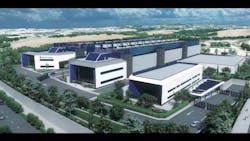A.I. Boom Drives Industrial Real Estate, Warehouse Developer Panattoni Into North American Data Center Construction
Following the lead of Prologis, the world’s largest industrial real estate operator, Doug Roberts, president of Panattoni’s North American development group said, “You want to be where the customer is, and right now the customer wants to be in the data center world.”
Prologis Chief Executive Hamid Moghadam highlighted this assertion by saying, “Every time we convert a warehouse to a data center, we pick up lots of value, like $500 a foot of value.”
Panattoni has already developed over 600 million square feet of industrial, office, and retail space, but the Panattoni announcement in August wasn’t about converting existing warehouse and logistics center space but rather building dedicated, AI-focused data centers.
A New, Dedicated Data Center Group
In fact, California-based Panattoni plans to develop a gigawatt (1 GW) of data center capacity over the next five years.
To drive this development, the company announced the creation of their North American Data Center Group, which will be led by new partner Adam Kramer, who will draw from his experience as an executive vice president at technology infrastructure provider Switch and chief executive of carbon-emissions management platform nZero to jump start this new group.
Working on multiple data center campuses worldwide, Kramer has experience in site selection, incentive creation, and data center development.
Notably in his previous roles, Kramer was successfully involved in securing venture capital funding as well as driving sustainability initiatives.
Both skills will be crucial to Panattoni’s plans for the creation of a North American data center portfolio.
“As someone who aligns well with our values, I am confident Adam will lead our newest division to great success and significantly enhance our position in this rapidly growing market," said Panattoni Chief Executive Officer Adon Panattoni.
Panattoni added, “Adam’s expertise in corporate strategy, government affairs, and sustainability, combined with his reputation as a leader in the data center industry, makes him well suited to direct our North American Data Center Group.”
Lining Up 100 - 500 MW Capacity Projects
According to Roberts, the current plan for Panattoni's new business unit is to build data centers with from 100 MW to 500 MW capacity, on both existing property currently owned as well finding new property to purchase, and on which to build new data center facilities.
Given the industry's history with the rapid leasing of data centers on that scale to hyperscalers such as Microsoft, Google, and AWS, Panatttoni is clearly tapping into a fertile market.
The company isn’t new to the process of building data centers; they announced a 48 MW campus in the Barcelona, Spain region in 2023.
Panattoni's Roberts also pointed out that the heavy interest in data centers nowadays reminded him of the shift in warehouse creation from traditional distribution centers to ecommerce fulfillment sites.
"This type of changing marketplace is no different," he said. “The data centers present an opportunity.”
If You Think About Building, They Will Come
The demand for data center space, especially in hot development areas, has pushed businesses from totally unrelated industries who need space for warehouses, into the data center business.
As reported by our Rich Miller, JK Moving company owner Chuck Kuhn kept buying land to build a warehouse for his business in Sterling, Virginia and immediately started get calls from data center companies wanting to purchase the land.
This experience repeated itself, and Kuhn eventually added land acquisition for data center development to his business portfolio. Kuhn has been involved in a number of significant data center projects including developments for CyrusOne, AWS, and Microsoft.
Kuhn's name has become so synonymous with data centers in the region that his most recent high-profile acquisition -- the Silver Line Development site in Sterling, announced at the beginning of August -- specifically states that despite previous authorization for over half a million square feet being approved for non-residential use, out of the 3.3 million square foot site, there will not be data center construction considered for that space.
About the Author



